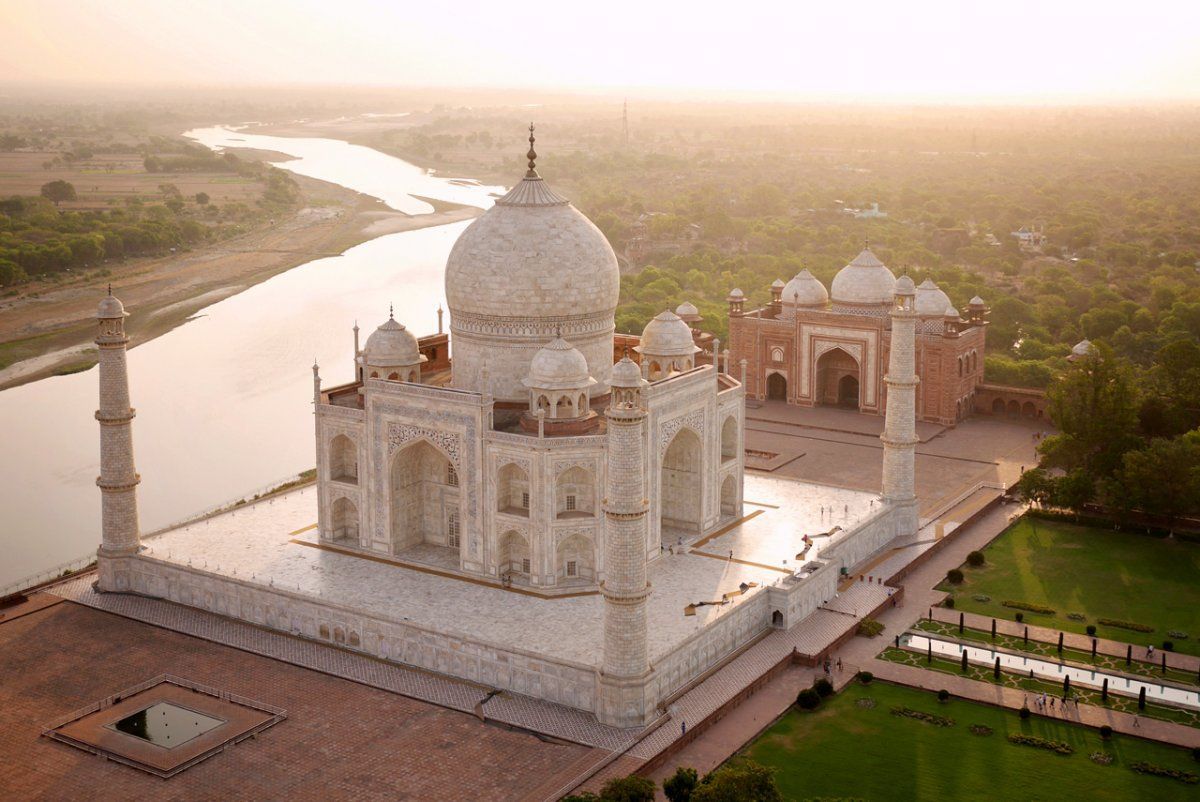
Tourists can explore the top 10 historical sites in India, which offer a glimpse into its rich cultural heritage and history.
Here are the top 10 historical places in India that are a must-visit for tourists:
1. Taj Mahal, Agra:
2. Red Fort, Delhi:
3. Qutub Minar, Delhi:
4. Jaipur City Palace, Rajasthan:
5. Ajanta and Ellora Caves, Maharashtra:
6. Hampi, Karnataka:
7. Khajuraho Temples, Madhya Pradesh:
8. Fatehpur Sikri, Uttar Pradesh:
9. Mahabalipuram, Tamil Nadu:
10. Sanchi Stupa, Madhya Pradesh:
1. Taj Mahal, Agra India:
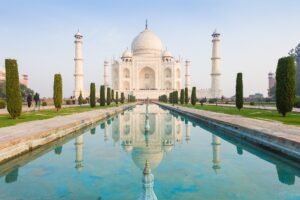
The Taj Mahal, located in Agra, India, is one of the most iconic and breathtaking monuments in the world, attracting millions of tourists each year.
Built by Emperor Shah Jahan in the 17th century as a mausoleum for his beloved wife Mumtaz Mahal, the Taj Mahal is a symbol of eternal love and beauty.
Its stunning white marble facade, intricate carvings, and symmetrical design make it a masterpiece of Mughal architecture and a UNESCO World Heritage Site.
Visitors to the Taj Mahal are immediately struck by its grandeur and beauty as they approach the main entrance gate.
As they enter the complex, they are greeted by the sight of the majestic mausoleum standing tall against the backdrop of lush gardens and reflecting pools.
The intricate marble inlay work, delicate carvings, and calligraphy adorning the walls and domes of the Taj Mahal showcase the craftsmanship and artistry of the Mughal era.
Tourists can explore the interior of the Taj Mahal, including the main chamber where the tombs of Shah Jahan and Mumtaz Mahal are enshrined in a serene and solemn setting.
The play of light and shadow on the marble surfaces creates a mesmerizing effect, especially during sunrise and sunset, making it a photographer’s paradise.
A visit to the Taj Mahal is not just a sightseeing experience but a journey into history, romance, and architectural brilliance.
It is one of the historical sites of India and a must-visit destination for tourists seeking to witness one of the world’s most beautiful and enduring symbols of love and craftsmanship.
2. Red Fort, Delhi India:
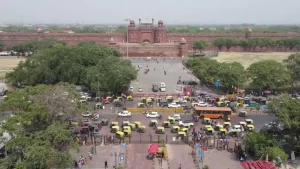
The Red Fort, located in the heart of Old Delhi, India, is a magnificent historical monument that offers tourists a glimpse into the grandeur and splendor of the Mughal era.
Built by Emperor Shah Jahan in the 17th century, the Red Fort served as the main residence of the Mughal emperors for nearly 200 years.
Its impressive red sandstone walls, intricate carvings, and sprawling gardens make it a must-visit destination for history enthusiasts and tourists alike.
As visitors approach the Red Fort, they are greeted by the imposing Lahori Gate, the main entrance to the fort.
Stepping inside, they are transported back in time to the era of Mughal royalty.
The fort’s impressive structures and architectural details showcase the opulence and grandeur of the Mughal dynasty.
Additionally, the Diwan-i-Aam, or Hall of Public Audience, and the Diwan-i-Khas, or Hall of Private Audience, are prime examples of intricate marble inlay work.
These decorative motifs adorn the fort’s interiors.
It is one of the famous historical sites of India, tourists can explore the various palaces, courtyards, and pavilions within the Red Fort complex, each offering a unique glimpse into the Mughal architectural style and design.
The fort’s iconic Moti Masjid, or Pearl Mosque, with its white marble facade and domes, is a serene and beautiful spot for visitors to admire and photograph.
A visit to the Red Fort is not just a journey through history but also an opportunity to immerse oneself in the rich cultural heritage of India.
The fort’s majestic beauty and historical significance make it a must-visit destination for tourists seeking to explore Delhi’s vibrant past.
3. Qutub Minar, Delhi India:
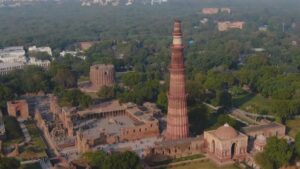
The Qutub Minar, located in Delhi, India, is one of the historical sites and a towering masterpiece of Indo-Islamic architecture.
It is also a UNESCO World Heritage Site that captivates tourists with its historical significance and stunning design.
Moreover, standing at a height of 73 meters, the Qutub Minar is the tallest brick minaret in the world, built by Qutb-ud-din Aibak in the 12th century as a symbol of victory and Islamic rule in India.
As tourists approach the Qutub Minar complex, they are greeted by the imposing minaret surrounded by lush greenery and ancient ruins, creating a serene and picturesque setting.
Furthermore, the intricate carvings, inscriptions, and geometric patterns adorning the minaret showcase the craftsmanship and artistry of the medieval period, making it a marvel to behold.
Visitors can climb the narrow staircase inside the Qutub Minar to reach the top and enjoy panoramic views of Delhi’s skyline, offering a unique perspective of the city’s rich history and modernity.
The surrounding complex also houses other architectural wonders, such as the Quwwat-ul-Islam Mosque, Alai Darwaza, and Iron Pillar of Delhi, each adding to the charm and historical significance of the site.
Tourists can explore the intricate details of the structures, learn about their historical importance, and marvel at the fusion of Hindu and Islamic architectural styles that define the Qutub Minar complex.
A visit to the Qutub Minar is not just a sightseeing experience but a journey through time, offering tourists a glimpse into India’s rich cultural heritage and architectural legacy.
4. Jaipur City Palace, Rajasthan India:
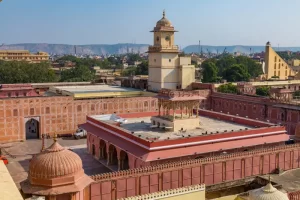
The Jaipur City Palace is one of the historical sites for tourists located in the heart of the Pink City of Jaipur, Rajasthan, India.
It is a magnificent architectural marvel that offers tourists a glimpse into the royal heritage and opulence of the Rajput rulers.
Furthermore, built in the 18th century by Maharaja Sawai Jai Singh II, the City Palace is a sprawling complex of courtyards, gardens, and palaces.
It showcases a blend of Rajput, Mughal, and European architectural styles.
As tourists enter the City Palace through the grand gate, they are greeted by a stunning facade.
The facade is adorned with intricate carvings, colorful frescoes, and ornate decorations that reflect the rich cultural heritage of Rajasthan.
Additionally, visitors can explore the various palaces and museums within the City Palace complex, each offering a unique insight into the history and lifestyle of the royal family.
The Chandra Mahal, or Moon Palace, is a highlight of the City Palace, with its exquisite architecture, beautiful paintings, and stunning views of the city.
The Mubarak Mahal, or Welcome Palace, houses a collection of royal costumes, textiles, and artifacts that showcase the grandeur and elegance of the Rajput court.
Tourists can also visit the Diwan-i-Khas, or Hall of Private Audience, and the Diwan-i-Aam, or Hall of Public Audience, where the Maharajas held court and conducted official business.
The City Palace is not just a historical monument but a living heritage site that continues to be used by the royal family for ceremonial events and functions.
A visit to the Jaipur City Palace is a journey through time, offering tourists a glimpse into the royal past and cultural richness of Rajasthan.
5. Ajanta and Ellora Caves, Maharashtra India:
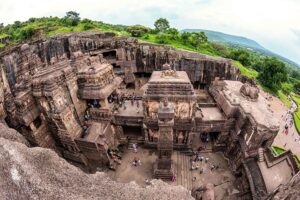
The Ajanta and Ellora Caves, located in Maharashtra, India, are a UNESCO World Heritage Site that showcases the rich cultural and artistic heritage of ancient India.
Additionally, the caves are a collection of rock-cut temples, monasteries, and shrines dating back to the 2nd century BCE.
They feature intricate carvings and paintings that depict stories from Hindu, Buddhist, and Jain mythology.
The Ajanta Caves, situated near the Waghora River, consist of 30 caves adorned with exquisite paintings and sculptures that reflect the artistic brilliance of the ancient craftsmen.
Additionally, visitors can marvel at the detailed frescoes depicting scenes from the Jataka tales, the life of Buddha, and various deities, all illuminated by natural light streaming through the cave openings.
The Ellora Caves, on the other hand, are a series of 34 caves that showcase a fusion of Hindu, Buddhist, and Jain architecture, with impressive rock-cut temples and monasteries carved out of solid rock.
Tourists can explore the Kailasa Temple in India, which is one of the historical sites, the largest monolithic structure in the world, dedicated to Lord Shiva, and marvel at the intricate carvings and sculptures that adorn its walls.
The Ajanta and Ellora Caves offer tourists a unique opportunity to immerse themselves in India’s ancient history and artistic legacy.
They provide a glimpse into the spiritual and cultural practices of bygone eras.
Moreover, a visit to these magnificent caves is a journey through time, allowing tourists to appreciate the craftsmanship and creativity of the artisans who created these masterpieces centuries ago.
6. Hampi, Karnataka India:
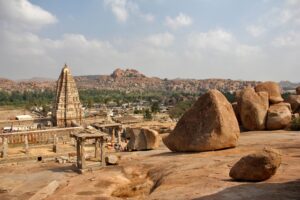
Hampi, located in the state of Karnataka, India, is one of the historical sites and a mesmerizing UNESCO World Heritage Site that transports tourists back in time to the glorious Vijayanagara Empire.
This ancient city is a treasure trove of architectural wonders, with its sprawling ruins, majestic temples, and stunning landscapes that captivate visitors from around the world.
Hampi is set against a backdrop of rugged boulder-strewn hills, lush banana plantations, and the meandering Tungabhadra River, creating a picturesque setting that is both serene and awe-inspiring.
Additionally, tourists can explore the numerous temples and monuments scattered across the Hampi ruins, each telling a story of the empire’s grandeur and cultural richness.
The Virupaksha Temple, dedicated to Lord Shiva, is a prominent attraction with its towering gopuram and intricate carvings that showcase the architectural brilliance of the Vijayanagara artisans.
The Vittala Temple is another must-visit site, known for its iconic stone chariot and musical pillars that produce melodious sounds when struck.
Apart from its historical and architectural marvels, Hampi also offers tourists the opportunity to engage in outdoor activities such as rock climbing, trekking, and cycling amidst the stunning landscape.
The Hippie Island across the river provides a laid-back atmosphere with cozy cafes, guesthouses, and breathtaking sunset views.
Moreover, a visit to Hampi is a journey through time and a chance to witness the grandeur of a bygone era.
It is, therefore, a must-visit destination for history buffs, architecture enthusiasts, and nature lovers alike.
7. Khajuraho Temples, Madhya Pradesh India:

Additionally, the Khajuraho Temples, located in Madhya Pradesh, India, are a stunning UNESCO World Heritage Site renowned for their exquisite architecture and intricate sculptures.
These temples, built between the 9th and 12th centuries by the Chandela dynasty, are a testament to the artistic and cultural achievements of ancient India.
Furthermore, the Khajuraho Temples are known for their intricate carvings that depict various aspects of life.
These include mythological scenes, celestial beings, everyday activities, and sensuous depictions of human figures.
Furthermore, each of the three groups of temples – Western, Eastern, and Southern – offers a unique glimpse into the rich heritage of the region.
Visitors to the Khajuraho Temples can marvel at the intricate craftsmanship and attention to detail displayed in the sculptures that adorn the temple walls.
The Western Group of temples, in particular, is the most well-preserved and showcases some of the finest examples of temple architecture in India.
The Lakshmana Temple, Kandariya Mahadev Temple, and Vishvanatha Temple are among the most famous structures in the complex, each with its own unique architectural style and decorative elements.
Apart from the architectural marvels, the Khajuraho Temples also host an annual dance festival.
This festival celebrates classical Indian dance forms against the backdrop of these ancient temples, adding a cultural dimension to the visitor experience.
A visit to the Khajuraho Temples is a journey back in time to a period of artistic splendor and spiritual devotion, making it a must-visit destination for history enthusiasts, art lovers, and spiritual seekers alike.
8. Fatehpur Sikri, Uttar Pradesh India:
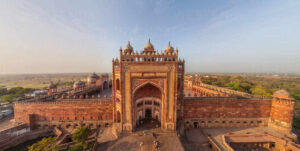
Fatehpur Sikri, located in Uttar Pradesh, India, is a historical marvel that transports tourists back to the Mughal era of Emperor Akbar.
Additionally, this UNESCO World Heritage Site is a well-preserved city that served as the capital of the Mughal Empire for a brief period in the late 16th century.
Moreover, the architectural grandeur of Fatehpur Sikri is evident in its stunning red sandstone buildings, intricate carvings, and expansive courtyards that reflect a blend of Persian, Indian, and Islamic architectural styles.
The city is home to several notable structures, including the Buland Darwaza, a massive gateway that is considered one of the tallest in the world and serves as an impressive entrance to the city.
Moreover, the Jama Masjid, with its elegant white marble domes and ornate carvings, is a striking example of Mughal architecture.
It is also a place of worship that continues to attract visitors from far and wide.
The Panch Mahal, Diwan-i-Khas, and Diwan-i-Aam are other architectural gems that showcase the opulence and grandeur of the Mughal court.
Apart from its architectural splendor, Fatehpur Sikri also holds historical significance as the birthplace of the famous Sufi saint, Sheikh Salim Chishti, whose tomb within the complex is a popular pilgrimage site.
A visit to Fatehpur Sikri offers tourists a glimpse into the rich history and cultural heritage of India’s Mughal period.
It is a must-visit destination for history buffs, architecture enthusiasts, and those seeking to immerse themselves in the grandeur of the past.
9. Mahabalipuram, Tamil Nadu India:
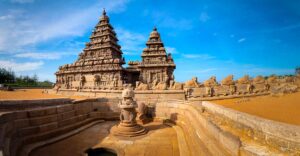
Mahabalipuram, located in Tamil Nadu, India, is a coastal town steeped in history and renowned for its ancient rock-cut temples and sculptures.
This UNESCO World Heritage Site, also known as Mamallapuram, is a treasure trove of architectural wonders that date back to the 7th and 8th centuries during the reign of the Pallava dynasty.
Furthermore, the town’s fame stems from its intricately carved monolithic structures, cave temples, and bas-reliefs depicting Hindu mythology and daily life scenes.
The Shore Temple, a stunning example of Dravidian architecture overlooking the Bay of Bengal, is one of the most iconic landmarks in Mahabalipuram and a must-visit for tourists.
The Shore Temple, a stunning example of Dravidian architecture overlooking the Bay of Bengal, is one of the most iconic landmarks in Mahabalipuram; consequently, it is a must-visit for tourists.
Apart from its architectural marvels, Mahabalipuram is also known for its beautiful beaches, making it a popular destination for both history enthusiasts and beach lovers.
Visitors can relax on the sandy shores, take a dip in the sea, or indulge in water sports like surfing and snorkeling.
The town is also a hub for traditional arts and crafts, with local artisans showcasing their skills in stone carving, sculpture, and handicrafts.
A visit to Mahabalipuram is a journey through time, offering tourists a unique blend of historical sites, culture, and natural beauty that makes it a must-visit destination in Tamil Nadu India.
10. Sanchi Stupa, Madhya Pradesh India:
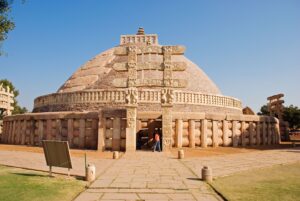
Sanchi Stupa, located in Madhya Pradesh, India, is a magnificent Buddhist monument that holds immense historical and religious significance.
This UNESCO World Heritage Site is one of the oldest stone structures in India, dating back to the 3rd century BCE during the reign of Emperor Ashoka.
The stupa is a hemispherical dome-like structure that enshrines relics of Lord Buddha and serves as a symbol of peace, unity, and enlightenment in the Buddhist tradition.
The Great Stupa at Sanchi is the most iconic structure in the complex; moreover, its intricately carved gateways, known as toranas, depict scenes from the life of Buddha and Jataka tales.
Furthermore, ancient Indian artisans showcase their skill and craftsmanship in these gateways, considered masterpieces of Buddhist art and architecture.
The stupa is surrounded by a series of smaller stupas, monasteries, and temples, creating a serene and spiritual atmosphere that attracts pilgrims and tourists alike.
Visitors to Sanchi Stupa can explore the ancient ruins, furthermore, marvel at the exquisite carvings, and ultimately soak in the peaceful ambiance of the site.
The lush green surroundings and panoramic views of the countryside add to the charm of this historical monument.
Sanchi Stupa is not only a place of architectural beauty but also a place of spiritual significance, making it a must-visit destination for those seeking to delve into India’s rich Buddhist heritage and history.







